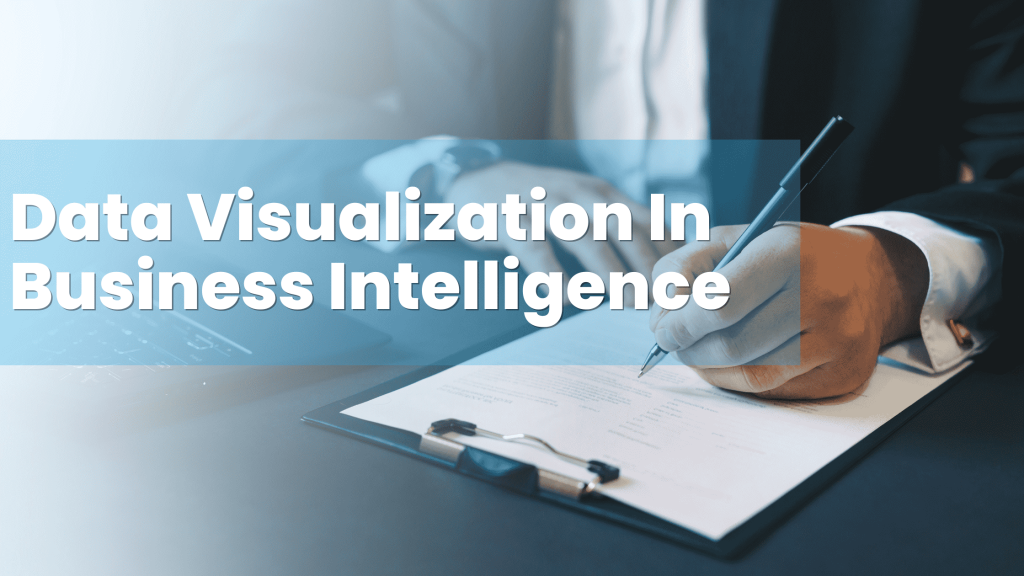Data Visualization for Business Intelligence: Analyzing Business Performance

Introduction
In today’s highly competitive and data-driven business landscape, organizations constantly generate and collect massive volumes of data from multiple sources, such as customer interactions, sales, supply chain processes, market trends, and more. However, without proper analysis, this data holds little value. To unlock its full potential, businesses need to convert this raw data into actionable insights to drive strategic decision-making.
This is where Business Intelligence (BI) and data visualization come into play. Business intelligence refers to the technological processes and tools that help companies gather, analyze, and transform data into meaningful insights. Central to BI is data visualization, a method of representing data through visual elements like charts, graphs, maps, and dashboards. These visualizations make it easier for decision-makers to interpret large datasets and derive actionable insights that can be used to assess and improve business performance.
In this article, we will explore how data visualization plays a pivotal role in modern BI, the various types of data visualizations, and how businesses can leverage these visual tools to improve operational efficiency, drive informed decision-making, and stay ahead in competitive markets.
The Role of Data Visualization in Business Intelligence
Data visualization is the process of converting raw data into graphical representations that make complex information easier to understand and analyze. In the context of business intelligence, data visualization plays a critical role in helping organizations make sense of vast amounts of data quickly and efficiently.
The key advantage of data visualization lies in its ability to highlight important trends, correlations, and outliers, which would otherwise be difficult to identify in textual or numerical datasets. By making data more digestible and easier to interpret, visualization tools empower decision-makers to derive actionable insights at a glance.
For instance, sales teams can visualize customer purchase patterns, marketing departments can track the performance of campaigns, and operations teams can monitor supply chain efficiency. The visual format also enables businesses to **tell a data-driven story**, helping stakeholders to comprehend the insights, collaborate, and take informed actions.
Incorporating data visualization into business intelligence ensures that data-driven insights are not only accessible to data analysts but also to non-technical personnel across the organization. This democratization of data enables faster, data-backed decisions, fostering agility and responsiveness in business operations.
Key Types of Data Visualizations for Business Performance Analysis
When it comes to analyzing business performance, different types of data visualizations serve specific purposes. Each visualization format helps to uncover unique insights depending on the nature of the data and the questions being addressed. Here are some of the most impactful types of visualizations used for business intelligence:
Dashboards
Dashboards provide a consolidated view of multiple key performance indicators (KPIs) in a single interface, giving decision-makers a comprehensive overview of business metrics in real-time. Dashboards are customizable, allowing different departments to monitor the metrics most relevant to their operations. For example, a financial dashboard might display metrics like revenue, profit margins, and expense ratios, while a sales dashboard may show conversion rates, lead generation statistics, and customer acquisition costs. The visual nature of dashboards ensures that all relevant data is accessible in one place, promoting efficient data analysis and decision-making.
Charts and Graphs
Traditional charts and graphs such as bar charts, pie charts, and line graphs remain fundamental tools for visualizing data trends and comparisons. These types of visualizations allow businesses to easily compare categories, track changes over time, and understand the distribution of data. For example, a bar chart can compare monthly sales across different regions, while a line graph can show how customer satisfaction ratings have evolved over the last few quarters.
Heat Maps and Geospatial Visualizations
Heat maps are used to show the intensity of data across a particular area, often using colour gradients. These are useful for identifying concentration patterns, such as regions with the highest customer demand or areas where marketing campaigns have been most effective. Geospatial visualizations (or maps) are another essential tool for businesses with geographically diverse operations, allowing organizations to track performance, sales, or resource allocation across different locations.
Interactive Visualizations
Interactive visualizations allow users to explore datasets by drilling down into specific metrics for more detailed analysis. These tools often enable decision-makers to filter data by date ranges, departments, or regions, providing greater flexibility in how data is viewed and analyzed. This is particularly useful for businesses that need to investigate the root cause of anomalies or trends, allowing them to uncover valuable insights that static visualizations may not reveal.
Benefits of Data Visualization for Business Intelligence
Data visualization offers numerous benefits when integrated into business intelligence strategies, enhancing decision-making capabilities and overall business performance. Below are some key advantages of leveraging data visualization tools:
Accelerated Decision-Making
One of the biggest benefits of data visualization is that it significantly speeds up the decision-making process. By presenting data visually, it becomes much easier and faster for decision-makers to interpret and act on the information. Rather than sifting through pages of raw data or reports, visualizations enable users to understand complex data sets within seconds. This is particularly important in fast-paced business environments where quick, data-backed decisions can offer a competitive advantage.
Increased Accessibility to Insights
Data visualization democratizes data by making insights accessible to everyone in the organization, not just data analysts or IT professionals. Visual dashboards, graphs, and charts simplify complex data, enabling employees from all departments to understand business performance metrics and act accordingly. This cross-functional accessibility improves collaboration between teams and promotes a data-driven culture throughout the organization.
Identification of Trends and Patterns
Visualizing data allows businesses to identify trends, correlations, and patterns that may not be evident in raw data formats. Whether it’s spotting seasonal sales spikes, tracking customer buying behaviour, or identifying operational inefficiencies, data visualization helps bring hidden insights to the surface. These insights enable businesses to take proactive actions, optimize strategies, and improve performance across multiple departments.
Enhanced Operational Efficiency
Data visualization tools eliminate the need for manual data analysis, improving operational efficiency. Automated data dashboards can pull data from multiple sources in real-time, reducing the time and effort required to compile reports. This enables businesses to allocate resources more effectively and focus on strategy execution rather than data preparation and reporting.
Best Practices for Effective Data Visualization in Business Intelligence
To get the most out of data visualization, it’s essential to follow certain best practices that ensure the clarity, accuracy, and usefulness of the visualizations:
Simplicity and Clarity
The most effective data visualizations are those that communicate insights in a clear and straightforward manner. Avoid cluttering the visual with too much information or unnecessary design elements, as this can overwhelm the viewer and obscure the key message. Stick to the essentials and prioritize simplicity to ensure that the most important data points are highlighted.
Proper Context
Always provide context for the data being visualized. This can include adding titles, labels, and annotations that explain what the visual represents and why it matters. Without context, viewers may misinterpret the data or draw incorrect conclusions.
Selecting the Right Visualization Format
Different types of data require different types of visualizations. For example, line graphs are great for showing trends over time, while pie charts are more effective for illustrating proportions. Be sure to choose the correct format that best represents the underlying data and supports the insights you want to convey.
Consistency in Design
Consistency in design, such as maintaining uniform colour schemes, fonts, and layouts, ensures that visualizations are easily navigable and interpretable across multiple reports or dashboards. This consistency also helps reinforce brand identity and fosters familiarity among users.
Popular Data Visualization Tools for Business Intelligence
There are numerous software tools available that facilitate the creation of data visualizations within a business intelligence framework. Some of the most widely used data visualization platforms include:
Power BI
Power BI is one of the most popular business intelligence tools, known for its interactive dashboards, data visualization capabilities, and seamless integration with Microsoft products. Power BI allows users to pull data from various sources and create customized reports with ease.
Tableau
Tableau is another leading data visualization platform, recognized for its powerful data analysis and visually compelling dashboards. Its drag-and-drop interface makes it easy to build complex visualizations that deliver deep insights into business performance.
Google Data Studio
Google Data Studio is a free, user-friendly tool that integrates with other Google services, including Google Analytics, Google Sheets, and Google Ads. It provides customizable reports with interactive data visualizations that are easy to share and collaborate on.
Qlik Sense
Qlik Sense is a data visualization tool known for its self-service capabilities, enabling users to explore data without needing advanced technical skills. Qlik’s associative model allows users to uncover insights from multiple datasets in real-time, making it ideal for interactive exploration.
Case Studies: How Data Visualization Enhances Business Performance
Data visualization has proven instrumental in improving business performance across multiple industries. Below are examples of how organizations have leveraged data visualization tools to unlock insights and drive better outcomes:
Retail
In the retail sector, data visualization tools help businesses track customer purchasing patterns, inventory levels, and sales performance. One retail company used real-time dashboards to visualize product sales across different regions and seasons, helping them optimize their supply chain and inventory management for peak demand periods.
Healthcare
Healthcare providers use data visualization to track patient outcomes, optimize treatment plans, and reduce operational inefficiencies. One hospital leveraged visual dashboards to monitor patient vitals and lab results in real-time, allowing doctors to make quicker, data-driven decisions, which ultimately improved patient care.
Finance
Financial institutions rely on data visualization to monitor market trends, portfolio performance, and risk.
Factors. A global bank utilized heat maps and charts to identify fraud patterns across multiple accounts, allowing them to proactively address security threats and minimize financial losses.
Conclusion
Data visualization is a critical component of business intelligence, enabling organizations to analyze and interpret vast amounts of data quickly and effectively. By transforming raw data into visual insights, businesses can identify trends, make informed decisions, and optimize their performance in real-time. As the role of data continues to grow in importance, adopting best practices for data visualization and leveraging the right tools will be essential for businesses looking to stay ahead in today’s competitive landscape.
--------------------------------
Guestbeat.com Notice!
Audience discretion is needed, Read TOS.
Submit Guest Post / Read Latest / Category List
App & Rate-Us / Subscribe Daily Newsletter (FREE)
-
Anand is a passionate writer with a proven track record of success in driving brand awareness, and customer engagement. he leverages her expertise in writing skills.



